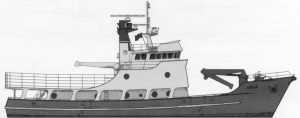Authors: Lisa Spitler and Jeff Williams | Alaska Maritime National Wildlife Refuge
 The M/V Tiglax (TEKH-lah – Aleut for eagle) is essential to managing the Alaska Maritime National Wildlife Refuge. The boat is 120 feet long and operates with a crew of 6. Fourteen scientists can live and work aboard. She has wet and dry labs and freezers for storing samples. Tiglax can deploy midwater and bottom trawls for sampling fish and plankton, and hosts bioacoustic transducers and data processors for sampling fish/plankton densities; and a SBE-21 thermosalinograph for diving seabird studies.
The M/V Tiglax (TEKH-lah – Aleut for eagle) is essential to managing the Alaska Maritime National Wildlife Refuge. The boat is 120 feet long and operates with a crew of 6. Fourteen scientists can live and work aboard. She has wet and dry labs and freezers for storing samples. Tiglax can deploy midwater and bottom trawls for sampling fish and plankton, and hosts bioacoustic transducers and data processors for sampling fish/plankton densities; and a SBE-21 thermosalinograph for diving seabird studies.
In a season, the Tiglax may sail to Forrester and St. Lazaria Islands in Southeast Alaska, or into Bering Sea as far as St. Matthew Island. Her main operations area is, however, the Aleutian Chain. Tiglax typically spends 120-160 days at sea covering as many as 20,000 nautical miles (at a top speed of 10 knots) traveling from the home port of Homer, Alaska out to Attu Island at the extreme west end of the Aleutian chain and back, several times a season.
The main role of the Tiglax is to transport service personnel, equipment, and supplies between work sites throughout the refuge. This year Tiglax departs Homer on May 17 to deploy FWS biologists and biological technicians at field camps in the Semidi Islands, on Aiktak, Buldir, Kiska, and Attu. These scientists focus on studying seabird colonies, but also work on reestablishing endangered habitats, they identify and monitor archaeological and historic sites, they monitor bird populations and human impacts on habitats, they maintain remote field facilities, and they patrol refuge waters.
Tiglax also serves as a seagoing research platform and living quarters for scientists from the Fish and Wildlife Service (FWS) or other federal or state agencies and universities. This year’s FWS projects include removal of invasive foxes from islands to restore native bird populations, collecting background information on contaminants left over from World War II, and monitoring other contaminant cleanup efforts on Attu and Amchitka, studying Kasatochi Island as she recovers from an eruption in 2008, lichen research on Adak, and visiting remote bird nesting colonies.
Non FWS partners include the National Marine Fisheries Service for sea lion studies, the University of Alaska, Institute of Marine Sciences and School of Fisheries, The Alaska Volcano Observatory, and the US Navy.
Stay with us for the “Summer of the Tiglax” as we report in on monitoring and research activities supported and facilitated by the Tiglax and crew!
